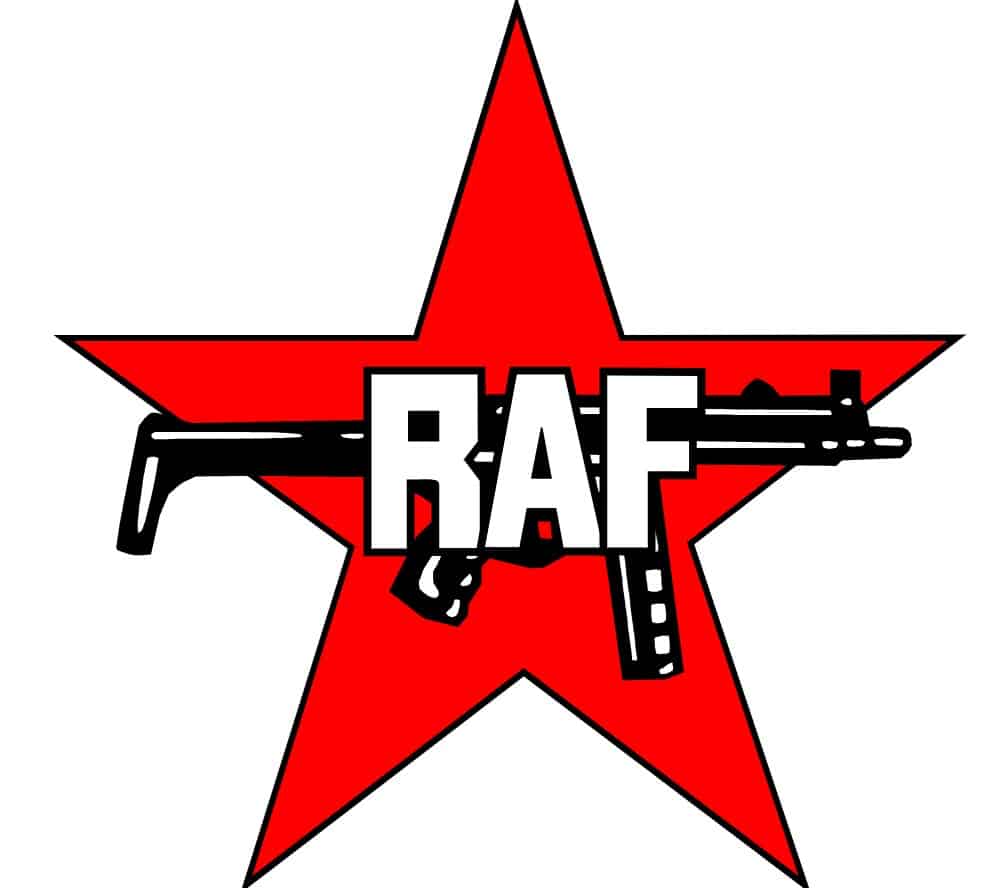It is at least singular if not significant of a relationship between the two phenomena that in the same years (the seventies of the twentieth century) two armed terrorist groups acted in Italy and in Germany, the Italian Red Brigades and the Red Army Faction ( Rote Armee Fraktion).
Both shared the same insignia: a Red Star, a typical sign of Communist Powers like the USSR and the Popular Republic of China.
The RAF described itself as a communist, anti-imperialist, and urban guerrilla group which was engaged in armed resistance against what it considered a fascist state.
While Red Brigades were fighting firstly against the State controlled by US multinational private companies and at the end regarding the State as a fascist one after all.

Members of the RAF generally self-defined as a Marxist–Leninist revolutionary group like the RB.
Early leadership included Andreas Baader, Ulrike Meinhof, Gudrun Ensslin, and Horst Mahler. The RAF engaged in a series of bombings, assassinations, kidnappings, bank robberies, and shoot-outs with police over the course of three decades. Its activities peaked in late 1977, which led to a national crisis that became known as the “German Autumn”.
The RAF has been held responsible for 34 deaths, including industrialist Hans Martin Schleyer, the Dresdner Bank head Jürgen Ponto, and the federal prosecutor Siegfried Buback, as well as many secondary targets, such as chauffeurs and bodyguards, with many others injured throughout its almost thirty years of activity; 26 RAF members or supporters were killed.
Perhaps a difference between the RB and the RAF is that while the former had primary political targets such as Aldo Moro, the latter had among their primary targets entrepreneurs, big businessmen such as industrialist Hanns Martin Schleyer, the Dresdner Bank head Jürgen Ponto.
But it is more of a nuanced difference as the RB also hit entrepreneurs and managers and the RAF also hit State officers like the federal prosecutor Siegfried Buback.
Although better known, the RAF conducted fewer attacks than the Revolutionary Cells, which is held responsible for 296 bomb attacks, arson, and other attacks between 1973 and 1995. The group was motivated by leftist political concerns and the perceived failure of their parent’s generation to confront Germany’s Nazi past and received support from Stasi and other Eastern Bloc security services.
Like Italian Red Brigades the German Red Army Faction shared similar or related if not often identical backgrounds and ideals or ideology: they were radicalized, like many in the New Left, and influenced by sociological developments, together with the background of counter-cultural movements.
Like Italian Red Brigades the German Red Army Faction shared post-war writings on class society and empire as well as contemporary Marxist critiques from many revolutionaries such as Frantz Fanon, Ho Chi Minh, and Che Guevara, as well as early Autonomism.
The German Red Army Faction was influenced by philosophers associated with the Frankfurt school Jürgen Habermas, Herbert Marcuse, and Oskar Negt in particular, and other Marxist philosophers like Tony Negri, the ideologist of Red Brigades.

At the roots of their ideology, it is claimed that property destruction during the Watts riots in the United States in 1965 influenced the practical and ideological approach of the RAF founders, as well as some of those in Situationist circles.
According to one former RAF member, in meetings with KGB in Dresden the group was also met by Vladimir Putin (!), then a KGB resident in East Germany. In these meetings, RAF members would discuss weapons that were needed for their activities, and pass a “shopping list” to the KGB.
However, this issue is controversial as it would question the exclusivity of the US-NATO covert inspiration of these groups by attributing a similar strategy to the Warsaw Pact.
Anyway Roberto Cavallaro an agent of some Italian State Security Agency infiltrated in neo-fascist groups and therefore opposed the Red Brigades before these facts, in the Black terrorism phase before the Red terrorism phase of the Strategy of Tension was sent by his group to a training camp for terrorists where he witnessed an incredible fact for him (and obviously for us too).
In this training camp for terrorists in an unspecified foreign country, perhaps in France, perhaps in North Africa, where Roberto Cavallaro as a neo-fascist supposedly dedicated solely and exclusively to Neo-Fascism, together with the black terrorists, also red terrorists were trained, presumably belonging to those groups which later formed the RB and RAF!

It is such an incredible fact that in my opinion, it cannot be a lie as it is far beyond what is likely according to common sense: the existence of a multi-sign Terrorist International.
Back to the roots of RAF ideology are the writings of Antonio Gramsci and Herbert Marcuse were drawn upon. Gramsci wrote on power, cultural, and ideological conflicts in society and institutions—real-time class struggles to play out in rapidly developing industrial nation-states through interlinked areas of political behavior. Marcuse wrote on coercion and hegemony in that cultural indoctrination and ideological manipulation through the means of communication (“repressive tolerance”) dispensed with the need for complete brute force in modern ‘liberal democracies.
His One-Dimensional Man was addressed to the restive students of the sixties. Marcuse argued that only marginal groups of students and poor alienated workers could effectively resist the system. Both Gramsci and Marcuse came to the conclusion that the ideological underpinnings and the ‘superstructure’ of society were vitally important in the understanding of class control (and acquiescence).
This could perhaps be seen as an extension of Marx’s work as he did not cover this area in detail. Das Kapital, his main economic work, was meant to be one of a series of books that would have included one on society and one on the state, but his death prevented the fulfillment of this.
The Federal Republic was exporting arms to African dictatorships, which was seen as supporting the war in Southeast Asia and engineering the remilitarization of Germany with the U.S.-led entrenchment against the Warsaw Pact nations
”Stammheim Death Night” came after the conclusion of the Landshut hostage crisis was announced in the late evening of October 17th, 1977, all the RAF members incarcerated in Stammheim committed ”suicide” during the following night.
I personally believe that this was a covert execution carried out by Deutsche Bundesrepublik, it is no coincidence that it was defined as fascist by the members of the RAF.
I cannot say whether it was an autonomous initiative of Deutsche Bundesrepublik or instigated by the CIA, NATO, or the KGB.
In fact, many of the radicals felt that Germany’s lawmakers were continuing authoritarian policies, and the public’s apparent acquiescence was seen as a continuation of the indoctrination the Nazis had pioneered in society (Volksgemeinschaft).
Ten years earlier on June 2nd, 1967, one of the terrorists ”suicided” Gudrun Ensslin speaking after the killing of a young pacific protester Benno Ohnesorg was a West German university student killed by a policeman during a demonstration in West Berlin wrote: ”They’ll kill us all. You know what kind of pigs we’re up against. This is the Auschwitz generation. You can’t argue with the people who made Auschwitz. They have weapons and we haven’t. We must arm ourselves!”
I believe that the historical legacy of Nazism must have left a deep mark on the political and legal culture of German souls despite the denazification of late forties in the state of emergency the State can and must carry out any action, even the most illegal and unconstitutional, to maintain public order.
This belief I think was shared then by the German politicians, the judiciary officers, and the police and the prison guards thought then, a reminiscence of the political philosophy of Karl Schmitt and his Political Theology.
I do not agree with them mainly on the ground that this controversial principle, admitted and not allowed was to be shared, one should have the courage to make it explicit and not omitted as an unspeakable hidden thought. Facing all the consequences of it. And not like a culpable thought in the mind of a criminal.
Make it explicit as the historic Nazis did by this they were somehow purifying themselves morally by virtue of this explicit declaration, in some way honestly.
After all this, the identity of insignia, ideals, types of actions, military techniques, and objectives between RB and RAF someone can still think that they weren’t both a franchisee of a franchisor (or maybe two opposite ones) still unknown.
And above all the identity of the principal ( or their symmetrical opposition) between the two opposing Blocks of the Cold War.
Like the RB the RAF members were nothing but patsies also condemned to self-destruction.
There is still a last final analogy between RB and RAF that is not in the nature of these groups but in the common reasons of limited sovereignty following to military alliance and defeat at the end of WWII.
To have been both the Axis powers, originally called the Rome–Berlin Axis, was a military coalition that initiated World War II and fought against the Allies.
To have been both until 1991 the western frontier along the Iron Curtain during the years of the Cold War.
To host both Italy and Germany many more NATO and US bases than all other European countries, in truth almost all.
To have been both the last Outpost, and the Bulwark of the West in those years.
To find more reasons for an analogy between RB and RAF, Italy and Germany see also:
Townshend, Charles (2002). Terrorism: A Very Short Introduction. Very Short Introductions. Oxford University Press. ISBN 978-0-19-280168-5.

Claudio Resta was born in Genoa, Italy in 1958, he is a citizen of the world (Spinoza), a maverick philosopher, an interdisciplinary expert, oh, and an artist, too.
Grew up in a family of scientists where many sciences were represented by philosophy to psychoanalysis, from economics to history, from mathematics to physics, and where these sciences were subject to public display by their subject experts family members, and all those who they were part of could participate in a public family dialogue/debate on these subjects if they so wished. Read Full Bio
ATTENTION READERS
We See The World From All Sides and Want YOU To Be Fully InformedIn fact, intentional disinformation is a disgraceful scourge in media today. So to assuage any possible errant incorrect information posted herein, we strongly encourage you to seek corroboration from other non-VT sources before forming an educated opinion.
About VT - Policies & Disclosures - Comment Policy




The Italian Red Brigades were, so called, NATO-army-controlled. This was proved by Dr. Daniele Ganser, a suisse historian & famous peace activist. https://en.wikipedia.org/wiki/Operation_Gladio
The red-army-fraktion was supported by the former GDR.
Comments are closed.